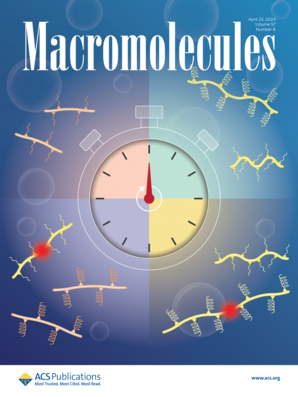edot基聚合物中的均偶联缺陷:它们对溶液聚集、氧化还原行为和电导率的影响
IF 5.1
1区 化学
Q1 POLYMER SCIENCE
引用次数: 0
摘要
直接芳基化聚合(DArP)是一种降低共轭聚合物合成复杂性的有效方法。这项工作报道了通过两种不同的DArP途径制备基于edot的共轭电活性聚合物,其中两种途径通过交换每个单体的偶联官能团(−H vs−Br)而不同。结果表明,氢化单体在聚合过程中更容易发生均偶联,得到了分子量和分散度相近但EDOT含量不同的两种聚合物样品。然后,通过与biEDOT共聚制备了过量EDOT含量的第三种聚合物。结果发现,无论是通过均偶联缺陷还是通过与biEDOT共聚,增加EDOT含量,氧化掺杂后的材料具有更低的氧化电位、更强的溶液聚集性和更高的固态电导率。本文章由计算机程序翻译,如有差异,请以英文原文为准。

Homocoupling Defects in EDOT-Based Polymers: Their Impact on Solution Aggregation, Redox Behavior, and Electrical Conductivity
Direct arylation polymerization (DArP) has emerged as an efficient method to lower the synthetic complexity of conjugated polymers. This work reports the preparation of an EDOT-based conjugated and electroactive polymer by two different DArP routes where the two paths differ by exchanging each monomer’s coupling functionality (−H vs −Br). It was found that the hydrogenated monomer was more likely to homocouple during polymerization, yielding two polymer samples of similar molecular weight and dispersity but different EDOT content. Then, a third polymer intentionally made with excess EDOT content was prepared by copolymerizing with biEDOT. It was found that increasing EDOT content, whether through homocoupling defects or copolymerization with biEDOT, resulted in materials that had lower oxidation potentials, stronger solution aggregation, and higher solid-state electrical conductivities after oxidative doping.
求助全文
通过发布文献求助,成功后即可免费获取论文全文。
去求助
来源期刊

Macromolecules
工程技术-高分子科学
CiteScore
9.30
自引率
16.40%
发文量
942
审稿时长
2 months
期刊介绍:
Macromolecules publishes original, fundamental, and impactful research on all aspects of polymer science. Topics of interest include synthesis (e.g., controlled polymerizations, polymerization catalysis, post polymerization modification, new monomer structures and polymer architectures, and polymerization mechanisms/kinetics analysis); phase behavior, thermodynamics, dynamic, and ordering/disordering phenomena (e.g., self-assembly, gelation, crystallization, solution/melt/solid-state characteristics); structure and properties (e.g., mechanical and rheological properties, surface/interfacial characteristics, electronic and transport properties); new state of the art characterization (e.g., spectroscopy, scattering, microscopy, rheology), simulation (e.g., Monte Carlo, molecular dynamics, multi-scale/coarse-grained modeling), and theoretical methods. Renewable/sustainable polymers, polymer networks, responsive polymers, electro-, magneto- and opto-active macromolecules, inorganic polymers, charge-transporting polymers (ion-containing, semiconducting, and conducting), nanostructured polymers, and polymer composites are also of interest. Typical papers published in Macromolecules showcase important and innovative concepts, experimental methods/observations, and theoretical/computational approaches that demonstrate a fundamental advance in the understanding of polymers.
 求助内容:
求助内容: 应助结果提醒方式:
应助结果提醒方式:


